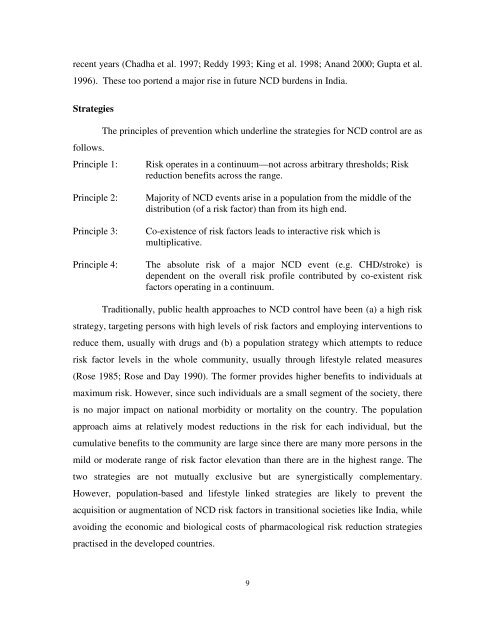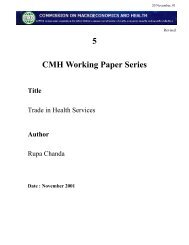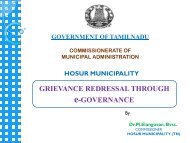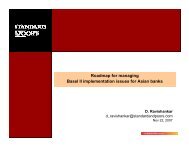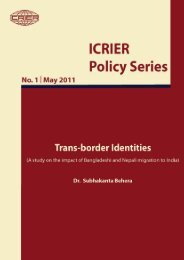prevention and control of non-communicable diseases - icrier
prevention and control of non-communicable diseases - icrier
prevention and control of non-communicable diseases - icrier
Create successful ePaper yourself
Turn your PDF publications into a flip-book with our unique Google optimized e-Paper software.
ecent years (Chadha et al. 1997; Reddy 1993; King et al. 1998; An<strong>and</strong> 2000; Gupta et al.<br />
1996). These too portend a major rise in future NCD burdens in India.<br />
Strategies<br />
follows.<br />
Principle 1:<br />
The principles <strong>of</strong> <strong>prevention</strong> which underline the strategies for NCD <strong>control</strong> are as<br />
Risk operates in a continuum—not across arbitrary thresholds; Risk<br />
reduction benefits across the range.<br />
Principle 2:<br />
Principle 3:<br />
Principle 4:<br />
Majority <strong>of</strong> NCD events arise in a population from the middle <strong>of</strong> the<br />
distribution (<strong>of</strong> a risk factor) than from its high end.<br />
Co-existence <strong>of</strong> risk factors leads to interactive risk which is<br />
multiplicative.<br />
The absolute risk <strong>of</strong> a major NCD event (e.g. CHD/stroke) is<br />
dependent on the overall risk pr<strong>of</strong>ile contributed by co-existent risk<br />
factors operating in a continuum.<br />
Traditionally, public health approaches to NCD <strong>control</strong> have been (a) a high risk<br />
strategy, targeting persons with high levels <strong>of</strong> risk factors <strong>and</strong> employing interventions to<br />
reduce them, usually with drugs <strong>and</strong> (b) a population strategy which attempts to reduce<br />
risk factor levels in the whole community, usually through lifestyle related measures<br />
(Rose 1985; Rose <strong>and</strong> Day 1990). The former provides higher benefits to individuals at<br />
maximum risk. However, since such individuals are a small segment <strong>of</strong> the society, there<br />
is no major impact on national morbidity or mortality on the country. The population<br />
approach aims at relatively modest reductions in the risk for each individual, but the<br />
cumulative benefits to the community are large since there are many more persons in the<br />
mild or moderate range <strong>of</strong> risk factor elevation than there are in the highest range. The<br />
two strategies are not mutually exclusive but are synergistically complementary.<br />
However, population-based <strong>and</strong> lifestyle linked strategies are likely to prevent the<br />
acquisition or augmentation <strong>of</strong> NCD risk factors in transitional societies like India, while<br />
avoiding the economic <strong>and</strong> biological costs <strong>of</strong> pharmacological risk reduction strategies<br />
practised in the developed countries.<br />
9


